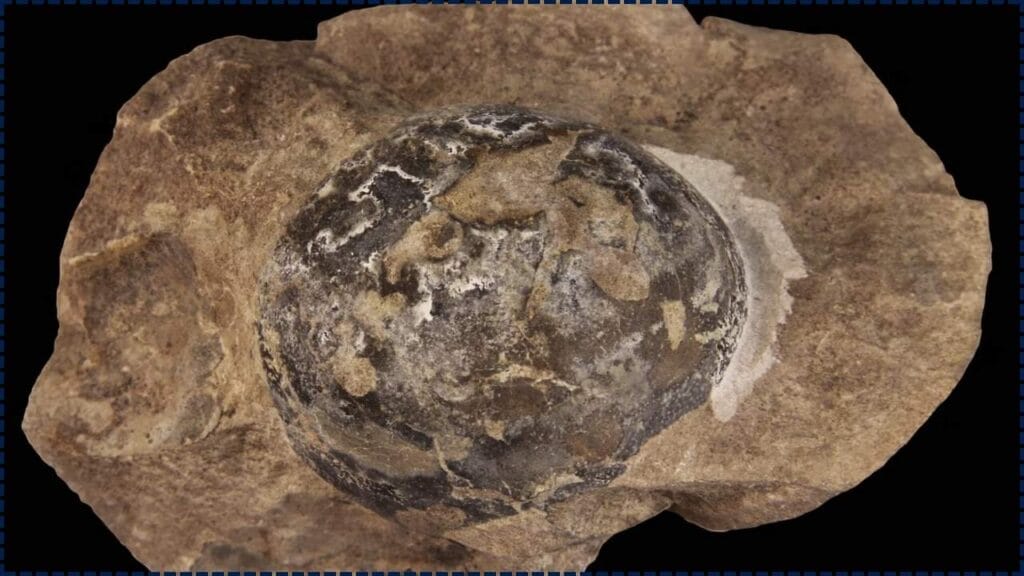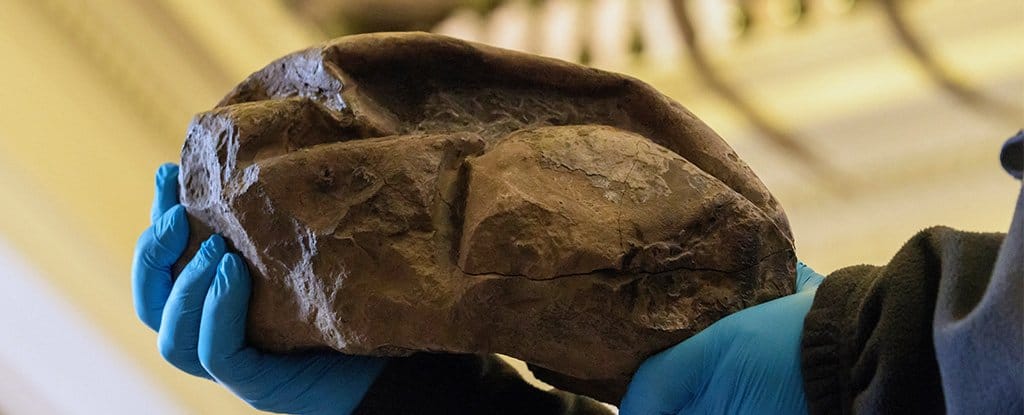In a heart-stirring discovery on Seymour Island, Antarctica, scientists have unearthed a 68-million-year-old fossilized egg, affectionately dubbed “The Thing.” This remarkable find, roughly the size of a deflated football, is more than a relic—it’s a bridge to our planet’s ancient past, inviting people everywhere to share in the awe of Earth’s history. This soft-shelled egg, possibly laid by a majestic marine reptile like a mosasaur, deepens our connection to the vibrant ecosystems that once thrived near the world’s southern edge.

This discovery does more than captivate scientists; it inspires us all to marvel at the intricate story of life on Earth. By revealing new insights into how ancient creatures nurtured their young, this egg reshapes our understanding of prehistoric ecosystems and the delicate balance of life. It’s a reminder of our shared responsibility to cherish and protect our planet’s rich legacy, uniting communities in a collective journey of curiosity and care. Together, we celebrate this glimpse into the past, fostering hope and wonder for the future of our world.
Giant Egg Buried for 68 Million Years Found in Antarctica
| Feature | Details |
|---|---|
| Discovery | Giant egg unearthed in Antarctica (Seymour Island), believed to be 68 million years old |
| Species Likely Involved | Possibly a mosasaur, a large marine reptile from the Cretaceous Period |
| Size of Egg | 11 by 8 inches (29 x 20 cm); second-largest egg ever discovered |
| Shell Type | Soft-shelled and leathery, not hard like traditional dinosaur eggs |
| Significance | Suggests some marine reptiles laid eggs instead of giving live birth |
| Published In | Nature |
| Nicknamed | “The Thing” by researchers, after the Antarctic sci-fi movie |
The discovery of the giant, soft-shelled egg in Antarctica is more than just a cool fossil story – it’s a major leap forward in our understanding of how ancient reptiles lived and reproduced. From its mysterious shell to the prehistoric nursery it was found in, every inch of this fossil tells a new story about Earth’s distant past. And it shows, once again, that the planet has many secrets left to share.
Where Was It Found and Why It Matters
Seymour Island, off the Antarctic Peninsula, has long been a hotbed for fossil hunters. During an expedition in 2011, researchers from Chile uncovered what looked like a collapsed football buried in ancient rock. Turns out, it wasn’t a football but a fossilized egg with a soft shell – and it dated back to the Late Cretaceous Period, just before the dinosaurs went extinct.
Most known fossilized eggs are hard-shelled, like chicken eggs on steroids. But this one? Soft, leathery, and kind of weird-looking. It didn’t have the structure scientists usually expect from dino eggs. In fact, the team thought it might have belonged to a marine creature. After careful analysis, the leading theory is that it came from a giant marine reptile like a mosasaur. That’s a big deal, folks.

What the Heck Is a Mosasaur?
If you’ve seen Jurassic World, you probably remember that whale-sized reptile jumping out of the water to grab a shark. That was a mosasaur. These guys were top predators in the oceans of the Cretaceous period. Think of them like the ancient ocean’s version of killer whales mixed with crocodiles.
Until now, most scientists thought mosasaurs gave live birth, like whales do today. But the discovery of this egg suggests that some marine reptiles laid eggs on land or in shallow water, which is a game-changer in understanding how these creatures lived and reproduced.
Breaking Down the Egg: Structure and Surprise
In a discovery that warms the heart, scientists have named a remarkable 68-million-year-old fossil egg found in Antarctica Antarcticoolithus bradyi. Measuring about 11 inches long and 8 inches wide, this treasure is the first soft-shelled fossil egg ever found in the region and the second-largest egg known to science, surpassed only by the extinct Madagascan elephant bird. This find invites us all to share in the awe of Earth’s ancient story, fostering a sense of unity as we marvel at the life that once flourished.
The egg’s thin, flexible shell, similar to those of modern lizards and snakes, surprises researchers, as it belonged to a creature as grand as a school bus. This gentle clue sparks curiosity about whether this ancient marine reptile, perhaps a mosasaur, ventured ashore to lay its eggs, nurturing its young with care. Such insights remind us of the delicate connections in nature, inspiring us to protect our planet’s legacy. Together, we celebrate this discovery, uniting in a shared commitment to cherish Earth’s history and safeguard its future for all.
Clues from the Cradle: Antarctica’s Fossil Nursery
In a heartwarming discovery, scientists have uncovered the remains of baby mosasaurs and plesiosaurs alongside the fossil egg Antarcticoolithus bradyi on Seymour Island, Antarctica. This finding paints a tender picture of a prehistoric nursery—a nurturing haven where ancient marine reptiles may have gathered to lay their eggs or welcome their young. This glimpse into the past invites us all to share in the wonder of Earth’s vibrant history, connecting us to the delicate cycles of life that have shaped our world.
This discovery transforms our view of dinosaur-era Antarctica, revealing it as a warm, thriving sanctuary filled with lush forests, flowing rivers, and the gentle presence of giant creatures caring for their offspring. Far from today’s icy landscape, this ancient cradle of life reminds us of our planet’s enduring capacity to nurture. It inspires us to come together, protecting the Earth’s precious ecosystems and fostering a shared commitment to preserve its beauty and balance for future generations, united in awe and care.
How Scientists Figured It Out
Paleontologists analyzed the egg’s microscopic structure and chemical composition to confirm its age and origin. According to Dr. Lucas Legendre, lead author of the study, the egg’s outer membrane and inner structure match what we see in modern reptile eggs. That means it likely hatched rather than just fossilizing without ever being laid.
Also, it didn’t contain a fossilized embryo, but its shell characteristics were enough to classify it as an egg – a real-deal prehistoric egg, not just some weird rock formation.
Major Lithium Deposit Found in McDermitt Caldera Could Boost US EV Industry: Check Details!
Researchers Warn of Fungi That Can ‘Eat You From the Inside Out’ Spreading in New Regions
Mysterious ‘Ghost’ Lineage Discovered In Tibet — DNA Study Reveals Ancient Human Secrets
Why It Changes the Game in Paleontology
This discovery opens up a brand-new field of questions:
- Did all marine reptiles lay eggs?
- Were soft-shelled eggs more common than we thought?
- Could other fossils be misidentified because we’ve only been looking for hard shells?
It also supports recent finds from Mongolia and Argentina that show some dinosaur species also laid soft-shelled eggs. That suggests soft-shelled eggs may have evolved independently in several lineages.
Practical Takeaways and Career Tie-Ins
If you’re in geology, paleontology, evolutionary biology, or even environmental science, this find is a reminder of how one fossil can change everything. For students and young professionals:
- Keep digging (literally or metaphorically). The next big discovery could be yours.
- Consider careers in paleogenetics, fossil restoration, and Antarctic research.
- The study of prehistoric reproduction is growing. There’s room for new ideas and fresh perspectives.
FAQs
Q: Was the egg from a dinosaur?
A: No. It likely came from a mosasaur, a marine reptile that lived during the age of dinosaurs.
Q: Why is a soft-shelled egg important?
A: Most fossil eggs are hard-shelled. Finding a soft-shelled one changes how we think reptiles reproduced.
Q: Could there be more eggs like this?
A: Probably! But soft-shelled eggs are harder to fossilize, so they’re super rare.
Q: How do we know the egg is 68 million years old?
A: Scientists dated the surrounding rock layers using radiometric techniques.
Q: What does this tell us about ancient Antarctica?
A: That it was warm, lush, and teeming with life – not the icy continent we see today.








